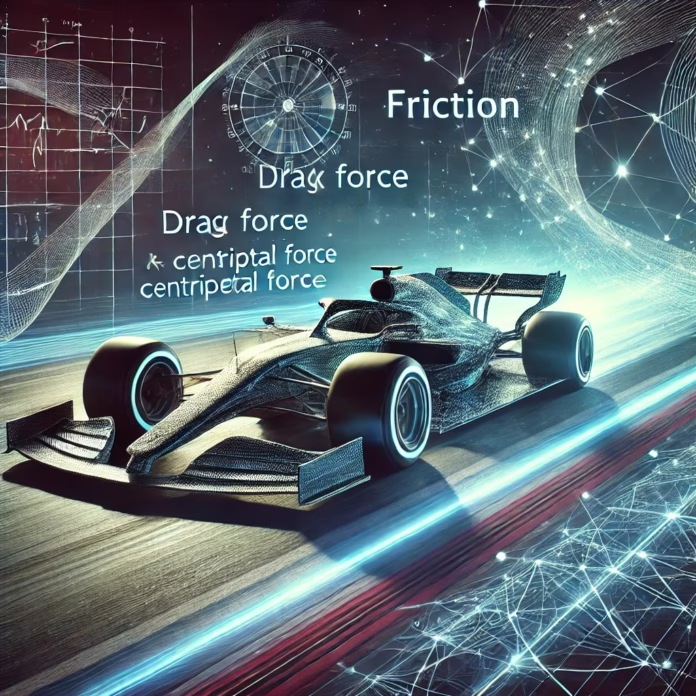The exhilarating world of auto racing is a spectacle of speed, skill, and precision. Beneath the roar of engines and the thrill of competition lies a sophisticated interplay of mathematics that governs every aspect of the sport. From designing racecars to strategizing pit stops, mathematics is an indispensable tool that drives the success of racing teams. In this article, we will explore how mathematical principles and formulas come into play in the high-speed world of auto racing.
Aerodynamics and Geometry
One of the most critical aspects of a racecar’s performance is its aerodynamics. Engineers rely heavily on geometry to design the car’s shape, ensuring minimal air resistance while maximizing downforce. The mathematical principle of drag force is given by the equation:
\(F_D = \frac{1}{2} \rho v^2 C_D A\)Where:
- \(F_D\) is the drag force,
- \(\rho\) is the air density,
- \(v\) is the velocity of the car,
- \(C_D\) is the drag coefficient,
- \(A\) is the frontal area of the car.
Minimizing \(C_D\) and \(A\) while maintaining sufficient downforce for traction is a delicate balance achieved through rigorous calculations and wind tunnel testing.
Tire Dynamics and Friction
The interaction between the tires and the racetrack is another area where mathematics is crucial. The frictional force, which determines the car’s grip, is described by:
\(F = \mu N\)Where:
- \(F\) is the frictional force,
- \(\mu\) is the coefficient of friction,
- \(N\) is the normal force exerted by the car on the tires.
In racing, engineers optimize tire compounds and pressure to maximize \(\mu\) while accounting for factors like temperature and track conditions. These optimizations allow the car to corner at high speeds without losing control.
Speed, Acceleration, and Lap Times
The relationship between speed, acceleration, and time is fundamental in racing. Kinematic equations help drivers and engineers understand the dynamics of acceleration and braking:
\(v = u + at\) \(s = ut + \frac{1}{2}at^2\) \(v^2 = u^2 + 2as\)Where:
- \(v\) is the final velocity,
- \(u\) is the initial velocity,
- \(a\) is the acceleration,
- \(t\) is the time,
- \(s\) is the displacement.
These equations enable teams to calculate optimal speeds and braking points for different sections of the track, ensuring the fastest lap times.
Fuel Efficiency and Strategy
Fuel management is a critical component of race strategy. Teams must calculate fuel consumption rates and plan pit stops accordingly. The rate of fuel consumption can be expressed as:
\(R = \frac{F}{T}\)Where:
- \(R\) is the fuel consumption rate,
- \(F\) is the total fuel used,
- \(T\) is the time.
Additionally, teams use calculus to integrate consumption over time, ensuring that fuel usage aligns with race strategy and minimizes time spent refueling.
The Physics of Cornering
Cornering is one of the most complex aspects of racing. The centripetal force required to navigate a curve is given by:
\(F_c = \frac{mv^2}{r}\)Where:
- \(F_c\) is the centripetal force,
- \(m\) is the mass of the car,
- \(v\) is the velocity,
- \(r\) is the radius of the turn.
Drivers and engineers use this formula to determine the maximum speed at which a car can safely navigate a turn without skidding off the track. Adjustments to downforce and tire grip are often made based on these calculations.
Data Analysis and Predictive Modeling
Modern racing relies heavily on data analytics. Sensors on the car collect data on speed, acceleration, tire wear, and engine performance. This data is analyzed using statistical methods and predictive modeling to optimize performance. Key tools include:
- Linear Regression: To identify trends in tire degradation or fuel efficiency over time.
- Fourier Analysis: To study vibration patterns in the car’s components.
- Machine Learning: To predict outcomes based on historical data and real-time inputs.
These methods allow teams to make informed decisions, enhancing their chances of success.
The fusion of mathematics and auto racing creates a thrilling synergy where precision meets performance. From the intricate calculations behind car design to the real-time strategies employed during a race, mathematics is the silent force that drives the sport forward. For students fascinated by both racing and math, this intersection offers a unique and exciting field of study—one where equations and adrenaline coexist at the speed of light.

